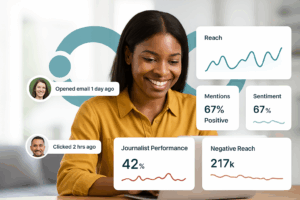Brand reputation management refers to the ongoing effort to monitor, shape, and protect how a business is perceived across various channels.
This includes what customers say, how the media reports on you, and what search engines surface about your company.
A strong brand reputation doesn’t just protect against negative press. It actively builds loyalty, attracts talent, supports growth, and sets the tone in moments of crisis.
What is Brand Reputation Management?
Brand reputation is how the public collectively perceives that company. The prescription is usually based on fundamental interactions, coverage, and commentary.
In other words, an image is what you say about your brand, while reputation is what others believe.
How Brand Reputation Differs From Brand Image
On the other hand, brand image is how a company presents itself. This includes logos, values, tone of voice, marketing, etc.
Reputation, Perception, and Trust: Key Differences
A company earns a reputation through performance, communication, and good or bad experiences.
Emotions or isolated experiences influence perception, while trust is built slowly and can be lost quickly. These factors determine whether stakeholders are willing to engage with your business.
Why Brand Reputation Matters
Most consumers nowadays look for social proof, like online reviews or third-party commentary, before making a purchase decision.
In fact, 90% of buyers admit that social proof influences their decisions. This is why a positive reputation is essential. It reduces friction and increases lifetime customer value.
Additionally, job seekers and business partners evaluate your brand based on public information, Glassdoor, LinkedIn, and industry forums.
Naturally, companies with stronger reputations will attract better talent, unlocking more collaborative opportunities.
Role in Investor Confidence and Market Value
Investors prioritise long-term credibility. Companies with positive public sentiment and strong governance enjoy greater stability, higher valuations, and resilience during market fluctuations.
Reputation as a Shield in Crises
When a crisis strikes, a trusted brand earns the benefit of the doubt. Proactive crisis communication and a history of openness can prevent one incident from becoming a full-scale reputational collapse.
How Brand Reputation is Built (Or Damaged)
Every interaction, promise kept or broken, shapes the story the world tells about your brand.
Customer Experience and Product Quality
A company’s product or service performance is the foundation of its reputation. Inconsistent quality or a bad communication experience leads to negative reviews and social backlash.
Media Coverage and Public Relations
Earned media and press mentions shape brand visibility and credibility.
This is why proper press release distribution is a key strategy that ensures key messages land in trusted publications, ideally read by your potential clients.
Social Media, Communities, and Influencers
Mentions on platforms like LinkedIn, TikTok, Reddit, or industry forums have a lasting impact. Of course, you should really engage with these communities and not just post content for the sake of posting.
Making engaging posts and interacting with other people’s posts can amplify reach and influence perception.
Online Reviews and User-Generated Content
Platforms like Trustpilot and Google Reviews directly reflect how customers perceive your brand. Responding with empathy and accountability shows others you care.
Search Results, Knowledge Panels, and AI Overviews
People searching for your company often form opinions before clicking anything. What appears in Google’s knowledge panel, AI summaries, or top news snippets defines first impressions.
Employee Behaviour and Corporate Actions
How your team behaves internally and publicly matters. Scandals, ethical lapses, or toxic cultures can all translate into lasting brand damage.
Core Pillars of Brand Reputation Management
Strong reputations are anchored in timeless principles that guide every brand decision and action.
Monitor: Track Sentiment and Signals Proactively
We recommend using media monitoring tools to stay informed when your brand is mentioned. Such tools also help you stay informed about competitor comparisons and sentiment shifts.
Respond: Address Feedback and Crisis Effectively
A quick, precise, and human response to customer complaints, PR issues, or negative reviews prevents escalation and shows accountability.
Amplify: Promote Positive Stories and Advocacy
Always ask satisfied customers to leave reviews, share their experience with your company, or even participate in case studies. Share success stories via the myNews platform or newsroom.
Improve: Integrate Insights Into Product and Service
Reputation management isn’t a PR-only function. Insights should guide product updates, support improvements, and leadership messaging.
Govern: Establish Rules, Ownership, and Oversight
Define who handles feedback, crisis response, content publishing, and escalation. Reputation management requires cross-functional ownership.
Monitoring and Listening: The Foundation
Reputation management starts with hearing what matters most: your audience’s unfiltered feedback.
Media Monitoring and Share of Voice
Track press mentions, competitor coverage, and sentiment through tools like media intelligence.
Social Listening and Sentiment Analysis
As we mentioned earlier, monitoring your social media is essential. What to do from there?
You could use social listening and AI-driven tools to help you interpret tone, sarcasm, or cultural nuance. Tag and categorise key topics to understand patterns and risks.
Reviews, Forums, and Community Signals
Don’t just monitor major platforms; include niche forums, Reddit threads, and Slack communities to catch early sentiment shifts.
Search Trends, Autocomplete, and AI Summaries
Observe how people search for your brand and what autocomplete suggestions or AI-generated summaries suggest.
Surveys, NPS, and Ongoing Brand Tracking
Run regular surveys and track Net Promoter Score (NPS) to measure brand health directly from your customers.
Key Metrics and KPIs for Reputation
The right metrics turn vague perceptions into actionable insights you can measure and improve.
Reputation Index or Score
Create a baseline score that blends sentiment, coverage quality, and volume using an internal or third-party model.
Sentiment and Message Pull-Through
Measure the percentage of positive, neutral, and negative mentions. Assess whether key messages are landing.
Coverage Quality and Domain Authority
Track whether mentions appear in high-authority media outlets and how they rank in search.
Risk Exposure and Issue Velocity
Measure how quickly negative stories escalate, where they originate, and whether response efforts are mitigating damage.
Business Impact Metrics (Traffic, Leads, Applications)
Connect media and sentiment data to business results, site traffic, leads, talent applications, and conversions.
Proven Strategies for Managing Reputation
Practical tactics help brands strengthen trust, recover from missteps, and stay ahead of public perception.
Building a Reputation-First PR Plan
Instead of chasing headlines, build a plan that supports trust, transparency, and consistent messaging. Integrate with your reputation management strategy.
Leveraging Thought Leadership and Executive Visibility
Publishing bylined articles establishes authority. However, this may not be enough for some industries.
We recommend looking for speaking engagement opportunities and expert commentary placements.
Managing Reviews and Community Engagement
Use automated prompts post-purchase to invite reviews. Set alerts to reply quickly across all platforms.
Crisis and Issue Management Frameworks
Define your “red flags,” response templates, and roles in advance. Build this into your broader brand reputation management system.
Corporate Social Responsibility (CSR) and ESG Initiatives
Audiences increasingly evaluate brands on ethics. Promote and practice initiatives that reflect long-term purpose, not just short-term PR wins.
Making Brand Reputation Management Operational
Embedding reputation management into daily workflows turns it from a reactive task into a proactive discipline.
Roles, Responsibilities, and Escalation Paths
Map out a clear reputation management team structure: from customer service to comms to the executive suite.
Tooling and Integrations (Monitoring, Newsrooms, Review Platforms)
Centralise efforts using integrated tools like myMedia, review platforms, and content hubs like myNews.
Taxonomy, Tagging, and UTM Best Practices
Structure campaigns and coverage with consistent tagging to measure effectiveness and attribute outcomes.
Automation, Reporting, and Executive Dashboards
Automate weekly digests and sentiment alerts. Make dashboards specifically for executives, support teams, and PR leads.
Governance, Ethics, and Compliance
Strong governance and ethical practices build a foundation of credibility that supports long-term brand value.
AI-Generated Content and Deepfake Disclosures
As AI-generated content grows, companies must disclose use and guard against false information and deepfakes, especially in high-trust industries.
Review Moderation and Right-of-Reply Policies
Define how to respond to valid and malicious reviews while maintaining transparency and compliance.
Privacy, Consent, and Regional Legal Considerations
Ensure monitoring and content collection align with GDPR, CCPA, and other regional standards.
Frameworks and Models to Guide Strategy
Established models offer a roadmap for structuring, executing, and evaluating your reputation efforts.
PESO Model for Reputation Building
Integrate the elements of Gini Dietrich’s PESO Model©, Paid, Earned, Shared, and Owned media, into a cohesive strategy that balances visibility and trust.
Moment Framework: Before, During, and After an Incident
Plan reputation responses across all phases, from preparation to resolution, so teams aren’t improvising mid-crisis.
Reputation Risk Matrix for Escalation Planning
Categorise potential risks by impact and likelihood, then define appropriate communication and operational responses.
Real-World Examples
Successful Product Recall Management
Barclays expanded access to its mobile app after social listening revealed a gap affecting teenagers. A quick response turned a complaint into favourable coverage.
Navigating a Leadership or PR Crisis
Microsoft rebuilt its image through internal culture shifts and public transparency, ultimately regaining trust and outperforming competitors.
Turning Customer Feedback Into Reputation Wins
Brands like Spotify regularly amplify user-generated content (e.g., Spotify Wrapped), turning customers into ambassadors and fuelling viral earned media.
Learn More About Brand Reputation Management
Brand reputation management is an essential business function, not a PR afterthought.
Businesses can gain trust, control risk, and create long-term value by combining ethical governance, regular communication, proactive monitoring, and the appropriate tools.
To explore how Newspress supports integrated brand reputation management, book a demo today.





